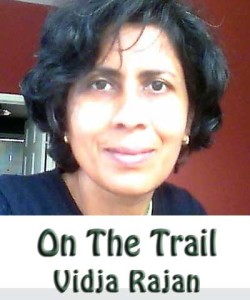By Vidya Rajan, Columnist, UnionvilleTimes.com
 Round trip distance: Several trails ranging from 1 mile to over 10 miles
Round trip distance: Several trails ranging from 1 mile to over 10 miles
Difficulty: Easy to moderate
Caution: Closed for hunting on occasion during deer season. Heed posted signs.
Website: http://www.natlands.org/preserves-to-visit/list-of-preserves/cheslen-preserve/
Trail Map: http://www.natlands.org/wp-content/uploads/downloads/2011/06/CheslenMap.pdf
Membership Information: https://getinvolved.natlands.org/join-or-renew
In Unionville’s own backyard, this 1,293 acre preserve run by the Natural Lands Trust is distinguished by its size, variety of features, scientific interest, and superb and varied trails. ChesLen was created, as its name suggests, from a merger of land donated by Chester County to add to a 568-acre parcel from philanthropist Gerry Lenfest, and further bolstered by the purchase of a parcel of land containing the Unionville Barrens – one of nine remaining serpentine barrens in Pennsylvania harboring rare and unusual plants that have adapted to the nutrient-poor soil. ChesLen has a variety of micro-ecological zones, including forested woodland, farmed fields, meadowland, and streams. This feeds a rich diversity of plant and animal life, and one of the pleasures of walking in ChesLen is coming across deer, foxes, a plethora of birdlife and birdsong, as well as an abundance of plant life. Follow posted signs for park use. The park is used by mounted fox hunters and by deer hunters so please do be careful and respectful of others’ use of the park. Dog waste bags are not provided. Please carry your own and clean up after your pet. Also, please consider membership of Natural Lands Trust to support their stewardship of this and other nature preserves in Pennsylvania. The Natural Lands Trust map shows the main trails in ChesLen and is shown in the Trail Map.
Here, I will describe two lollipop-shaped loop trails (shown in red on the Natural Lands Trust Trail Map for ChesLen) linked at the base, with the center at the parking lot on Cannery Road, about 1 mile from either the Route 162 or Route 842 turnoffs. I have created a Google map of the two trails below with photographs at http://g.co/maps/w76et. Each lollipop trail can be hiked independently from the Cannery Road parking lot. There are several other trails branching off the main loop, many of which can be used to extend your hike still further if the 6 miles the joined trails represent does not satisfy your hiking itch. ChesLen has a number of other trails which I will describe in the future. ChesLen is an important bird area, so don’t forget your binoculars and field guide.
The North loop trail is a simply beautiful 3-mile round trip down to the Brandywine River. Walk along the main path into ChesLen and when the path bifurcates quickly twice in succession (0.2 miles), take the left path on each occasion. At the point of bifurcation, notice the tree. A few years ago, this tree was struck by lightning and one-half of it was destroyed. That’s a lesson. If thunderstorms threaten, there are better places to be than exposed on the top of this hill. On a bright day, the view is quite gorgeous, and one can see for miles in every direction. On a foggy day, this view is spectacular with treetops looming out of the mist.
Follow the curving path down the hill and across the fields. Passing through an opening in the hedgerow (0.21 mile), look at the branches by the side of the path if you are here in the fall or early winter. Male deer often rub the velvet off their antlers on lower brush, sometimes peeling off the bark. Electricity transmission towers march through a wide clearing across the path and off into the distance. At the bottom of the field (0.75 mile), down a sharp slope is the “Potter’s Field”, a cemetery of about two hundred unmarked graves. This field dates back to the year 1800, and is the burial place of some of the residents of a poorhouse and asylum that once stood here.
Cross the railroad tracks (caution! – this railroad is operational) and another wide field opens up which the trail loops around, and about three-quarters of which is bounded by the Brandywine River. The field can be hiked in either direction. Here, I describe the clockwise path. Turning left, the path parallels the railway tracks and then turns to mirror the curves of the Brandywine. Beware – the soft, inviting looking, knee-high plants with toothed-edged leaves are stinging nettles which cause a burning sensation followed by an agonizing itching when touched. Apparently the tender leaves make a great soup. Having once fallen off a bike in England into a patch of nettles, I am not anxious to encounter them again, even as food!
Looping around the field, still shadowing the river, a wide view opens up back across the fields to a hunting platform. Corcoran’s Bridge spanning the river at this point is an entryway for canoeists, so please be aware of trailers coming over the bridge. At this point, it is possible to cut across the field back to the railway line. Choosing to stay on the path flanking the river, you may occasionally get a glimpse of herons and other water birds – the other side of the river is a nesting ground, so please do not cross the river to the other bank. The path eventually loops right back around to the hunting platform and a sharp left turn takes you back to the railway line and Potter’s Field, and along the path uphill back to the parking lot.
A number of paths lead off this loop, and many of these are quite a lot of fun to wander around. Some lead back through the woods, ford streams and wander up and down hills. It’s not unusual to come suddenly upon a deer grazing, or surprise a fox stalking silently through the high grass. Blackbirds chatter loudly from long stalks of grass, and turkey vultures drift lazily overhead. This place is really lovely. Enjoy.
To get to the South loop trail, cross the road (be careful – cars coming over the hill cannot see you!) and get onto the mowed path by the fence line. The path runs adjacent to the maintenance buildings, which are currently under reconstruction, and curves between planted fields. As soon as the path turns left (~0.1 mile), a vista opens up with fields on either side with shadowy woods beyond and in the distance. On a sunny day in the summer, look for swallows swooping about catching insects. If you’re lucky, you’ll see Eastern Bluebirds –delayed hay harvesting at ChesLen to July has allowed the ground nesting birds to stay in their nests until after the fledglings leave. This restoration of habitat has recovered the local population of these birds. The information plaque at the top of the hill (0.56 mile) describes habitat restoration in more detail.
The path then veers left (look here later in the summer for wineberries on brambles edging the path) and downhill over the stream and bifurcates (0.81 mile). Take either path – they loop back to this point. Here, I describe the clockwise path going uphill to the left. Russian olive with small cream-colored flowers on a silvery gray bush, and multiflora rose will perfume your path, but do not be beguiled – these plants are invasive and are rapidly encroaching ChesLen. In the field on the other side of Lost Trail Road, you may see some curious cattle observing you. The path hugs the fence line and then turns right, parallel to Route 162. On the left is a small pond, which rings and booms with the sounds of frogs’ mating calls during spring. Follow the path around to the parking lot (1.58 mile) and then turn right to come back on the loop trail to the point where the path crossed the stream. Along the way, listen for woodpeckers in the woods. An information plaque along the way (2.26 mile) explains stream-side life. Retrace your steps on the other side of the stream and you will return to the parking lot where you started (2.81 mile).
There are lots of ancillary paths that branch off the main trail on both loops. Most of these are quite well marked, and make for a pleasant amble around the fields and through the woods on a nice day. Some paths border private properties so please stay on the marked trail.
Nearby places of interest:
Indian Hannah’s Memorial: Hannah Freeman or Indian Hannah, as she was also known, was the last member of the tribe of Lenni-Lenape in Chester County. She was born near what is now Route 52 near Longwood, and died in 1802. A memorial stone to her was first raised in 1909, at the site of her passing. The memorial was rescued from dilapidation by a group of historical preservationists who cleaned up and rededicated the memorial. The memorial site is on Route 162 about 100 yards north of Corcoran’s Bridge at ChesLen.
Stargazer’s Stone: Charles Mason and Jeremiah Dixon used Embreeville in Chester County as a center for their surveying operations for the eponymous line that separates Pennsylvania from Maryland. The stone itself is near Harlan House on Route 162 and Stargazer’s Road. Harlan House itself was probably the earliest house built in Newlin Township. Both stone and house are now on the National Register of Historic Places.
Naturalist Notes:
Serpentine barrens: The serpentine barrens are a unique and fragile grassland ecosystem. Thin soil overlying serpentinite, a greenish metamorphic rock rich in magnesium, nickel and chromium, and low in calcium, is exceedingly hostile to plant growth. About 174 species have adapted to these soil conditions, and some 15 endangered, threatened, and rare species and the animal life they support are found in no other habitats. The barrens now occupy a mere 9 acres, one-sixth of their size 70 years ago. Curiously enough, human practices, such as deliberate firing, mining, and clearing were necessary to maintain this open grassland ecosystem, which would otherwise have quickly been swallowed by woodland. Other human practices, such as land development, changing farming practices and introduction of new species have eradicated many of the original barrens in south-eastern Pennsylvania, making protection of the remaining seven areas, of which Unionville Barrens is the largest, of special importance. While these lands still remain unprotected by law, private conservation agencies working in the area have worked to purchase, protect and preserve these barrens.
A superb treatise on the Unionville Barrens, from which most of the information presented here was obtained can be found at Protecting the Unionville Barrens by Roger Latham.








are bikes allowed on these trails? i would love to ride my bike from Media to this loop and then back…thanks!
Thanks, Kristen. I am glad the details are helpful.
I do have a couple of mistakes to correct:
1. In the South loop, the road the trail parallels is Kelsall Road, and the cattle are often in the field on the other side. Lost Trail Road is perpendicular to Kelsall Road.
2. Seasons change, and when I wrote this in May, Russian olive and Multiflora rose were still in bloom. Those blooms have now gone, and the white blossoms with the strong perfume that you see now are Honeysuckle.
Nice article, Vidya! Thanks for all the links. I know there are many trails around, but finding the trailhead (including parking) and seeing any kind of map (with distances) is another thing entirely.
You can download Natural Lands Trust’s free app, ExploreNLT, for iPhone and Android, to access trail maps to all our publicly accessible nature preserves!